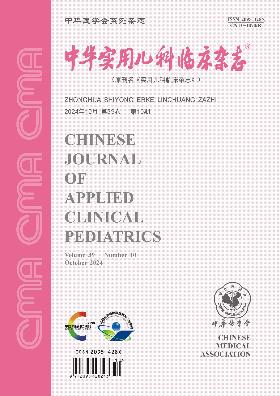骨髓染色体核型及其在神经母细胞瘤骨髓转移早期诊断中的临床意义
Q4 Medicine
引用次数: 0
摘要
目的总结分析儿童神经母细胞瘤(NB)骨髓转移初诊时染色体核型结果,探讨其临床意义。方法应用G显带技术对2015年1月至2017年12月在北京儿童医院血液肿瘤中心定期就诊的患者进行染色体核型分析,随访至2018年12月31日,分析其临床特点和预后。结果(1)骨髓转移患者120例,其中男孩74例,女孩46例,≥18个月者98例(81.7%)。60例染色体正常者中,国际神经母细胞瘤分期系统(INSS)-Ⅳ期56例(93.3%),INSS-Ⅳs期4例;低危(LR)2例,中危(MR)9例,高危(HR)49例(81.7%);MYCN基因扩增7例。60例染色体异常患者均为INSS-Ⅳ期;MR 1例,HR 59例(98.3%);MYCN基因扩增14例。(2) 在60名(50%)染色体异常的儿童中,4名儿童出现数量异常,14名儿童出现结构异常,42名儿童同时出现数量和结构染色体异常。染色体21、10、11缺失是数量异常中最常见的;11q、1p、3p节段的结构异常发生率较高。(3) 17例染色体正常的儿童在4至44个月的随访期间出现肿瘤进展或复发,31例染色体异常的儿童在2至42个月的跟踪期间出现肿瘤发展或复发。所有儿童的3年总生存率和无事件生存率分别为60.0%和48.4%;正常染色体组儿童的3年总生存率为74.2%,无事件生存率为65.7%;染色体异常儿童的3年总生存率和无事件生存率分别为47.5%和24.9%。大多数肿瘤进展或复发的儿童都有10号染色体缺失,11q、1p、2p节段结构异常。结论Nb儿童肿瘤细胞染色体异常率高,但重复率低,个体差异明显。10号染色体的缺失、11q、1p和2p区段的异常区域结构可能是NB的不良预后因素。骨髓样本的染色体核型分析是可行的,可以为更准确的风险分层和治疗提供依据。关键词:神经母细胞瘤;骨髓转移;染色体核型本文章由计算机程序翻译,如有差异,请以英文原文为准。
Chromosome karyotype of bone marrow and its clinical significance in the first diagnosis of neuroblastoma with bone marrow metastasis
Objective
To summarize and analyze the results of chromosome karyotype in children with neuroblastoma (NB) with bone marrow metastasis at first diagnosis, and to discuss the clinical significance.
Methods
G-banding was applied to the analysis of chromosome karyotype of patients who were regularly treated in the Hematological and Oncology Center in Beijing Children′s Hospital from January 2015 to December 2017, and all the patients were followed up until December 31, 2018.Their clinical features and prognosis were analyzed.
Results
(1) There were 120 cases with bone marrow metastasis, including 74 boys and 46 girls, and 98 cases (81.7%) were ≥ 18 months.Among 60 cases with normal chromosome, 56 cases (93.3%) were in International Neuroblastoma Staging System(INSS)-Ⅳ phase, and 4 cases in INSS-Ⅳs phase; there were 2 low-risk (LR) cases, 9 intermediate-risk (MR) cases, and 49 high-risk (HR) cases (81.7%); 7 cases had MYCN gene amplifications.All 60 patients with chromosome abnormalities were in INSS-Ⅳ phase; there was 1 case in MR and 59 cases (98.3%) in HR; 14 cases had MYCN gene amplifications.(2) Among 60 children (50%) with chromosome abnormalities, 4 children had number abnormalities, 14 children had structural abnormalities, and 42 children had both number and structural chromosome abnormalities.Chromosome 21, 10, 11 deletions were the most common in number abnormalities; structural abnormalities involving 11q, 1p, 3p segments had a high incidence.(3) Seventeen cases of children with normal chromosome had tumor progression or recurrence during the 4 to 44-month follow-up period, and 31 cases of children with chromosome abnormalities had tumor progression or recurrence during the 2 to 42-month follow-up period.The 3-year overall survival rate and event-free survival rate of all children were 60.0% and 48.4%, respectively; children in the normal chromosome group had a 3-year overall survival rate of 74.2% and an event-free survival rate of 65.7%; the 3-year overall survival rate and event-free survival rate of children with chromosome abnormalities were 47.5% and 24.9%, respectively.Most children suffering from tumor progression or recurrence had chromosome 10 deletion, and abnormal structure of 11q, 1p, 2p segments.
Conclusion
The chromosomal abnormality rate of Nb children's tumor cells is high, but the repetition rate is low, and the individual difference is obvious.The deletion of chromosome 10, abnormal regional structure of 11q, 1p and 2p segments may be poor prognostic factors for NB.Chromosome karyotype analysis of bone marrow samples is feasible, which can provide a basis for more accurate risk stratification and treatment.
Key words:
Neuroblastoma; Bone marrow metastasis; Chromosome karyotype
求助全文
通过发布文献求助,成功后即可免费获取论文全文。
去求助
来源期刊

中华实用儿科临床杂志
Medicine-Pediatrics, Perinatology and Child Health
CiteScore
0.60
自引率
0.00%
发文量
14243
期刊介绍:
Chinese Journal of Applied Clinical Pediatrics ( semi-monthly ) is a core journal of paediatrics under the supervision of China Association for Science and Technology, sponsored by Chinese Medical Association and undertaken by Xinxiang Medical College. Founded in 1986, it is openly circulated both at home and abroad. The journal has several columns, such as Expert Forum, Experimental Research and Paediatric Surgery, which are mainly for paediatric medical workers and medical researchers in hospitals. Its purpose is to reflect the new theories and technologies in paediatric medicine and scientific research at home and abroad, and to promote academic exchanges.
Chinese Journal of Applied Clinical Pediatrics is a source journal of China Science Citation Database (CSCD), a core journal of Peking University, a source journal of Chinese science and technology paper statistics (China Science and Technology Core Journals), a core academic journal of RCCSE, a high-quality scientific and technical journal of China, a high-quality scientific and technical journal of China Association for Science and Technology, and a high-quality scientific and technical journal of China Biomedical Science and Technology Association. We have been published in China Biomedical Literature Database (SinoMed), China Knowledge Network, Wanfang Data Knowledge Service Platform, China Academic Journal Abstracts, Scopus Database, Chemical Abstracts (USA), Japan Science and Technology Agency (JSTA) Database, Copernicus Abstracts (Poland), Abstracts of the Centre for Agricultural and Biological Sciences (CABS) of the United Kingdom, Cambridge Scientific Abstracts ProQuest Database, WHO Medical Journal of the Western Pacific Region (WMPR), and WHO Medical Journal of the Western Pacific Region (WMPR) of the United States. We have been included in dozens of authoritative databases at home and abroad, such as WHO Western Pacific Region Index of Medicine (WPRIM), Ullrich's Guide to Periodicals, and so on.
 求助内容:
求助内容: 应助结果提醒方式:
应助结果提醒方式:


